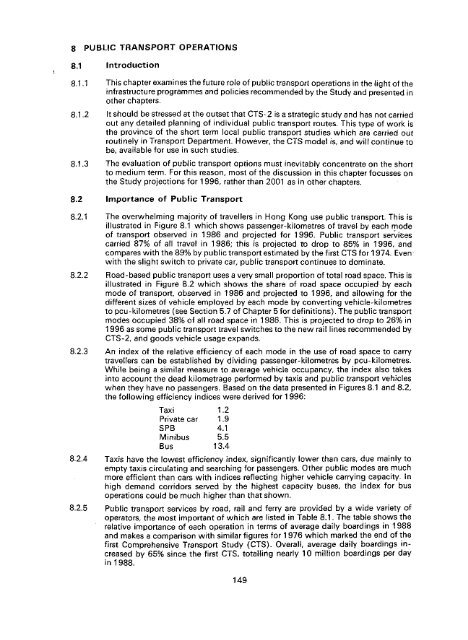Untitled - HKU Libraries - The University of Hong Kong
Untitled - HKU Libraries - The University of Hong Kong
Untitled - HKU Libraries - The University of Hong Kong
- No tags were found...
You also want an ePaper? Increase the reach of your titles
YUMPU automatically turns print PDFs into web optimized ePapers that Google loves.
88.1 introduction8.1.1 This chapter examines the future role <strong>of</strong> public transport operations in the light <strong>of</strong> theinfrastructure programmes and policies recommended by the Study and presented inother chapters.8.1.2 It should be stressed at the outset that CTS-2 is a strategic study and has not carriedout any detailed planning <strong>of</strong> individual public transport routes. This type <strong>of</strong> work isthe province <strong>of</strong> the short term local public transport studies which are carried outroutinely in Transport Department. However, the CTS model is, and will continue tobe, available for use in such studies.8.1.3 <strong>The</strong> evaluation <strong>of</strong> public transport options must inevitably concentrate on the shortto medium term. For this reason, most <strong>of</strong> the discussion in this chapter focusses onthe Study projections for 1 996, rather than 2001 as in other chapters.8.2 Importance <strong>of</strong> Public Transport8.2.1 <strong>The</strong> overwhelming majority <strong>of</strong> travellers in <strong>Hong</strong> <strong>Kong</strong> use public transport. This isillustrated in Figure 8.1 which shows passenger-kilometres <strong>of</strong> travel by each mode<strong>of</strong> transport observed in 1986 and projected for 1996. Public transport servicescarried 87% <strong>of</strong> all travel in 1986; this is projected to drop to 85% in 1996, andcompares with the 89% by public transport estimated by the first CTS for 1974. Even"with the slight switch to private car, public transport continues to dominate.8.2.2 Road-based public transport uses a very small proportion <strong>of</strong> total road space. This isillustrated in Figure 8.2 which shows the share <strong>of</strong> road space occupied by eachmode <strong>of</strong> transport, observed in 1986 and projected to 1996, and allowing for thedifferent sizes <strong>of</strong> vehicle employed by each mode by converting vehicle-kilometresto pcu-kilometres (see Section 5.7 <strong>of</strong> Chapter 5 for definitions). <strong>The</strong> public transportmodes occupied 38% <strong>of</strong> all road space in 1986. This is projected to drop to 26% in1996 as some public transport travel switches to the new rail lines recommended byCTS-2, and goods vehicle usage expands.8.2.3 An index <strong>of</strong> the relative efficiency <strong>of</strong> each mode in the use <strong>of</strong> road space to carrytravellers can be established by dividing passenger-kilometres by pcu-kilometres.While being a similar measure to average vehicle occupancy, the index also takesinto account the dead kilometrage performed by taxis and public transport vehicleswhen they have no passengers. Based on the data presented in Figures 8.1 and 8.2,the following efficiency indices were derived for 1996:Taxi 1.2Private car 1.9SPB 4.1Minibus 5.5Bus 13.48.2.4 Taxis have the lowest efficiency index, significantly lower than cars, due mainly toempty taxis circulating and searching for passengers. Other public modes are muchmore efficient than cars with indices reflecting higher vehicle carrying capacity. Inhigh demand corridors served by the highest capacity buses, the index for busoperations could be much higher than that shown.8.2.5 Public transport services by road, rail and ferry are provided by a wide variety <strong>of</strong>operators, the most important <strong>of</strong> which are listed in Table 8.1. <strong>The</strong> table shows therelative importance <strong>of</strong> each operation in terms <strong>of</strong> average daily boardings in 1988and makes a comparison with similar figures for 1976 which marked the end <strong>of</strong> thefirst Comprehensive Transport Study (CTS). Overall, average daily boardings increasedby 65% since the first CTS, totalling nearly 10 million boardings per dayin 1988.149
















